This site is supported by our readers. We may earn a commission, at no cost to you, if you purchase through links.
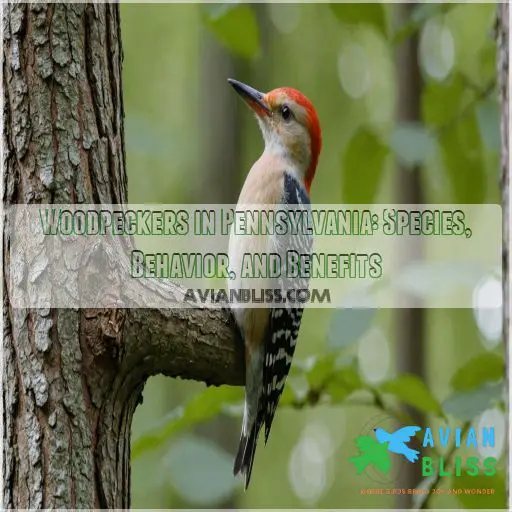
These skilled foragers use their specialized beaks to hunt insects, store food, and even drum out territorial tunes.
While they can sometimes cause a ruckus, woodpeckers play a key role in our ecosystems.
Learn how to spot the different species, understand their behaviors, and even attract them to your yard.
Plus, discover how to handle any pesky woodpecker problems while respecting these protected birds.
Get ready to appreciate the woodpeckers in your Pennsylvania neighborhood!
Table Of Contents
- Key Takeaways
- Woodpeckers in Pennsylvania: Physical Characteristics
- Woodpecker Behavior and Habitat
- Woodpeckers in Pennsylvania: Species and Distribution
- Woodpeckers in Pennsylvania: Diseases and Safety Concerns
- Dealing With Woodpeckers in Pennsylvania
- Woodpeckers in Pennsylvania: Benefits and Concerns
- Frequently Asked Questions (FAQs)
- What is the most common woodpecker in Pennsylvania?
- Are woodpeckers good to have in your yard?
- Do woodpeckers mean I have termites?
- What to do about a woodpecker pecking your house?
- What is the lifespan of woodpeckers in Pennsylvania?
- How do woodpeckers affect local ecosystems in Pennsylvania?
- Are there any woodpecker conservation efforts in Pennsylvania?
- Can woodpeckers be domesticated as pets in Pennsylvania?
- What is the impact of climate change on Pennsylvanias woodpecker population?
- Conclusion
Key Takeaways
- Get to know the diverse cast of woodpeckers in Pennsylvania – from the diminutive Downy to the majestic Pileated. Learn to spot their unique features and appreciate their role in maintaining a healthy ecosystem.
- Discover the fascinating behaviors of woodpeckers, like their skilled drumming, clever food storage, and strategic nesting. Understand how to coexist peacefully with these protected birds in your backyard.
- Be aware of the potential health risks from woodpecker droppings, and take proper precautions to prevent the spread of diseases like histoplasmosis and West Nile virus. Prioritize safety while respecting these feathered friends.
- Explore creative solutions to manage woodpecker damage, such as using one-way doors, sealing entry points, and deploying visual deterrents. With a little creativity, you can keep your home safe without harming these beneficial birds.
Woodpeckers in Pennsylvania: Physical Characteristics
When you’re identifying woodpeckers in Pennsylvania, notice how they manage to blend into the landscape with their varied sizes and striking feather patterns.
Their beaks aren’t fashion statements but essential tools for drilling and forage-finding, and you might appreciate the male’s red head markings as their version of a fancy hat.
Size and Color Variations
When you start spotting woodpeckers, you’ll notice they’re diverse in size and color patterns. Ranging from the tiny downy woodpecker to the big Pileated Woodpecker, there’s quite a size comparison going on!
- Males often sport red head markings.
- Juveniles like the Red-headed Woodpecker begin life with brown heads.
- Seasonal changes may alter these patterns.
Beak Shape and Function
Woodpeckers’ chiseled beaks are perfectly adapted for drilling into trees and structures to extract insects, sap, and other food sources.
Their strong, pointed bills allow them to chisel through tough bark and wood, making them skilled foragers.
This specialized beak shape has evolved over time to suit the woodpeckers’ diverse feeding preferences across different species, like the Nebraska woodpecker species.
Head and Body Feather Patterns
Exploring the feather patterns of woodpeckers in Pennsylvania feels like decoding nature’s art. Their mix of white, brown, and red creates a daring canvas.
These patterns aren’t just for show; they’re a key to identification, like a signature.
Imagine spotting these:
- Northern Flicker’s spotted wings
- Yellow-bellied Sapsucker‘s black and white design
- Red-bellied’s striped back
- Downy Woodpecker’s delicate checkered wings
- Hairy Woodpecker’s bold contrasts
Distinctive Markings on Male Woodpeckers
Male woodpeckers in Pennsylvania show striking red markings.
Picture a Downy Woodpecker with its tiny red cap, like a nature-loving fashion statement.
Here’s a handy table:
| Species | Red Markings | Other Features |
|---|---|---|
| Downy Woodpecker | Spot on head | Small size |
| Hairy Woodpecker | Back of head | Longer bill |
| Northern Flicker | Whisker markings | Black spots |
Woodpecker Behavior and Habitat
Exploring the fascinating world of woodpecker behavior, you’ll discover these birds have a knack for drumming and storing food—their way of marking territory and ensuring winter survival.
Whether nesting or foraging, woodpeckers might make your home part of their habitat, sometimes tapping into wooden siding with a rhythm that could put any drummer to shame!
Drumming and Communication
Woodpeckers are renowned for their distinctive drumming, which serves as a means of communication and territorial defense.
By drumming on hollow trees, wooden structures, or even metal surfaces, these birds convey a range of messages, from staking claim to a nesting site to attracting mates.
Their drumming patterns can vary in frequency, duration, and rhythm, allowing them to effectively signal their presence and intentions to other woodpeckers in the area.
Food Storage and Foraging
In terms of food storage and foraging, woodpeckers in Pennsylvania are pretty clever.
They stash away nuts and insects in tree crevices, creating food caches like nature’s little pantries.
It’s a strategy for winter survival, ensuring they’ve a snack when times get tough.
Imagine them as forest conservationists, munching insects to maintain tree health!
Nesting and Territorial Behavior
After storing food, woodpeckers turn their attention to nesting and territory. They’ll search out the perfect spot to settle down, often favoring tree cavities for their homes.
It’s not all peck and no play, as they:
- Defend territories with distinct drumming patterns
- Engage in elaborate mating rituals
- Guarantee safety through strategic nest site selection
Isn’t love a lively song?
Interaction With Humans and Structures
While nesting and marking territory, woodpeckers sometimes treat your house like an all-you-can-drill buffet!
Their drumming noises can become a real "peck-tacular" annoyance.
To keep the peace, consider visual deterrents or one-way doors.
You might even find these feathered friends fascinating enough to lure them to your garden with suet and nuts.
It’s about balance, not battle!
Woodpeckers in Pennsylvania: Species and Distribution
Pennsylvania is home to a diverse array of woodpecker species, each with its own unique characteristics and behaviors.
From the diminutive Downy Woodpecker to the striking Pileated Woodpecker, these birds play a key role in the local ecosystem, just as they do in Michigan’s diverse woodpecker species.
They can often be spotted in both urban and rural areas.
Downy Woodpecker
Exploring woodpecker habitats, you’ll meet the Downy Woodpecker, the backyard’s dainty darling.
Its small stature doesn’t stop it from having a big personality!
With a diet that includes insects and seeds, they’re often heard with their cheerful calls.
Recognize them by their tiny bill and distinctive markings.
They nest in trees across North America, enjoying vast freedom in their range.
Hairy Woodpecker
In Pennsylvania’s forests and backyards, the Hairy woodpecker thrives, showcasing its distinctive longer bill.
Its habitat is diverse, stretching across North America, where it adorns itself in black and white feathers like a nature’s tuxedo.
With their rhythmic drumming calls, they announce territories and navigate woodland life, feasting on insects while avoiding predators.
These woodpeckers make nests in sturdy tree cavities, safe from prying eyes.
Northern Flicker
Ah, the Northern Flicker—a woodpecker with flair!
With its vibrant wings, the Yellow-shafted Flicker flaunts golden feathers, while the Red-shafted sports red.
These ground feeders enjoy an ant-rich diet, yet their "wick-a-wick" calls echo from the trees.
Nesting in cavities, these flickers are nature’s eccentric drummers, adding rhythm to Pennsylvania’s diverse woodpecker chorus.
Pileated Woodpecker
The Pileated Woodpecker is a true sight to behold – a massive bird with a bright red crest and striking black and white plumage, a common species in Massachusetts.
These forest-dwelling giants specialize in hunting carpenter ants, chiseling away at rotting trees to uncover their prey.
Though shy in remote areas, Pileated woodpeckers can become quite comfortable visiting backyard feeders, [like the ones mentioned for attracting woodpeckers](https://avianbliss.com/woodpeckers-in-new-york/).
Red-bellied Woodpecker
Like the Pileated Woodpecker, the Red-bellied Woodpecker charms with its striking looks.
You’ll find these birds throughout the Eastern U.S.
They’re known for their varied diet and distinctive sounds.
When identifying them, note their red heads and black-and-white striped backs.
For added enjoyment, here’s a quick list:
- Range: Eastern U.S.
- Diet: Insects, fruits, seeds
- Nesting: Tree cavities
Red-headed Woodpecker
You’ll find the Red-headed Woodpecker’s bold red head striking!
Spot them in open areas with grasses and woodlands, especially those oak-rich spots.
Fed on insects, nuts, and fruits, they’re nature’s cleanup crew.
Unfortunately, their range is shrinking northward, needing conservation focus.
Nesting in tree cavities, they’re magnets for birdwatchers with a penchant for brightly feathered miracles!
Yellow-bellied Sapsucker
Shifting from the showy Red-headed Woodpecker, you’ve got the Yellow-bellied Sapsucker migrating into Pennsylvania. This bird’s sap diet involves drilling holes in trees, occasionally becoming a neighborly nuisance!
On the lighter side, here’s what captivates:
- Migration patterns
- Tree sap menu
- Tree damage hotspots
- Friendly competition with other sap-loving critters
Woodpeckers in Pennsylvania: Diseases and Safety Concerns
While woodpeckers are fascinating birds, their droppings can carry serious diseases like histoplasmosis and West Nile virus.
Taking proper precautions is important to prevent the spread of E. coli, salmonella, and other harmful bacteria when dealing with these protected creatures.
Diseases Carried by Woodpeckers
Bird droppings can be quite the mischievous culprit when it comes to spreading diseases.
As astonishing as it sounds, they can house pathogens affecting both human health and woodpecker health.
It’s critical to practice disease prevention with proper sanitation measures to keep bird safety high and your surroundings pristine.
Histoplasmosis and West Nile Virus
When dealing with woodpeckers in Pennsylvania, consider the health risks—bird droppings can harbor histoplasmosis and West Nile Virus.
To keep your space safe, take bird control seriously.
Implement disease prevention methods like cleaning droppings promptly and installing safety measures to deter these feathered friends.
E. Coli and Salmonella Risks
Now, besides their drumming habits, woodpeckers can present risks like E. Coli and Salmonella found in bird droppings, affecting human health.
Keep safe with these steps:
- Stay clear of droppings.
- Use gloves when cleaning.
- Wash hands thoroughly.
- Regularly maintain bird feeders.
- Make sure your backyard is safe.
Preventing Disease Transmission
Proper hygiene is important when dealing with woodpecker droppings. Always wear gloves and avoid touching the droppings directly. Thoroughly clean any affected areas with a disinfectant solution to eliminate potential disease-causing bacteria like E. coli and Salmonella. Take these simple precautions to keep your family safe and prevent the spread of harmful illnesses.
Woodpecker droppings can contain harmful bacteria.
To protect yourself from these bacteria, follow these steps:
| Precaution | Rationale | Recommended Action |
|---|---|---|
| Wear Gloves | Protect Hands | Wear Disposable Gloves |
| Avoid Direct Contact | Prevent Illness | Do Not Touch Droppings |
| Disinfect Surfaces | Kill Bacteria | Use Bleach or Disinfectant |
| Wash Hands | Maintain Hygiene | Soap and Water |
Dealing With Woodpeckers in Pennsylvania
Dealing With Woodpeckers in Pennsylvania
If you’ve ever had a woodpecker use your house as a drum set, you know how persistent they can be.
Don’t worry; there are creative solutions out there to keep these enthusiastic drummers from making your home their personal stage!
One-Way Doors for Exclusion
Consider using one-way doors as a clever DIY solution to manage woodpecker behavior.
These nifty devices allow woodpeckers to leave but not return, keeping them out for good.
They’re effective, but they can also be more cost-effective than extensive repairs.
However, remember that timing is key—installation must occur when there are no eggs or young present.
Sealing Entry Points and Repairs
You’ve spotted woodpecker damage and it’s high time for some DIY solutions! Block common entry points like vents or cracks with sturdy materials. Think of it as your home’s armor against these peckish visitors.
If you’re feeling overwhelmed, don’t hesitate to call in professional help.
Custom Solutions for Protection
Customized solutions can safeguard your home from persistent woodpeckers.
Birdhouse designs with specific entry sizes discourage larger species.
Woodpecker-proof siding materials like vinyl or fiber cement create a barrier.
Custom mesh barriers over vulnerable areas prevent access.
Deterrent paint with unpleasant textures or scents repel woodpeckers without harming them.
Get creative to protect your property!
Visual Deterrents and Repellents
After securing your home with custom solutions, explore savvy visual deterrents to keep woodpeckers at bay.
Use reflective surfaces like CDs, evoking a disco ball, twirling in the breeze.
Add motion-activated sprinklers for an unexpected splash.
Place predator decoys as silent sentinels.
Bird distress calls add surprise to the mix.
These DIY deterrents keep your yard woodpecker-free, without missing a beat!
Protected Species and Regulations
Visual deterrents can stop woodpeckers from turning your house into a drum set.
It’s important to remember that woodpeckers are protected by bird conservation laws, as they are in Arkansas.
So, if they decide your home is their new jam space, you must follow legal regulations. Protect their habitat while managing human-wildlife conflict, ensuring species management and legal protection remain priorities.
Woodpeckers in Pennsylvania: Benefits and Concerns
You’ll find woodpeckers aren’t just fascinating creatures but also beneficial for maintaining healthy ecosystems by controlling insect populations.
Woodpecker percussion concerts, however, might feel like a concert you didn’t ask for when they vigorously drum on your house!
Ecological Role and Benefits
Woodpeckers play a key role in maintaining a healthy ecosystem.
Their drilling helps control insect populations, like carpenter ants, that can damage trees.
Their nest cavities provide homes for other wildlife.
Plus, their presence indicates a thriving forest – so you can take pride in hosting these remarkable birds on your property.
Attracting Woodpeckers to Your Yard
Want to make your yard a woodpecker paradise? Try setting up woodpecker feeders stocked with delicious suet recipes.
Nest boxes can also entice these feathered friends.
A yard design with native trees brings nature to your doorstep, creating a welcoming habitat.
Signs of Infestations and Damage
Spotting signs of woodpecker damage can feel like hunting for hidden treasures—albeit ones you’d rather not find.
Keep your eyes peeled for:
- Trees with numerous holes: A sign of an insect feast.
- Siding or trim with fresh peck marks: Like woodpecker graffiti.
- Persistent drumming noises: Probably not just the neighbor’s band practice.
Frequently Asked Questions (FAQs)
What is the most common woodpecker in Pennsylvania?
Imagine stepping into a Pennsylvanian forest, and you’re nearly guaranteed to spot Downy Woodpeckers.
Small, sociable, they’re often seen twitting around feeders.
Their approachable nature makes them a beloved staple, adding charm to your backyard.
Are woodpeckers good to have in your yard?
In your yard, woodpeckers might seem pesky with their drumming, but they’re nature’s pest control, munching on insects and bringing vibrant life to your landscape.
They’re like having lively feathered inspectors keeping your garden balanced!
Do woodpeckers mean I have termites?
Seeing a woodpecker on your home doesn’t necessarily mean you have termites, but it could indicate underlying issues that may attract them.
Keep an eye out for other signs and consider a professional inspection to be sure.
What to do about a woodpecker pecking your house?
To deter a woodpecker from pecking your house, hang shiny objects like CDs or aluminum foil to create a reflective deterrent.
Alternatively, use a fake predator or install woodpecker-friendly alternatives like suet feeders to redirect attention.
What is the lifespan of woodpeckers in Pennsylvania?
Woodpeckers in Pennsylvania generally live between 11 and 15 years, depending on the species. The Black-backed and Pileated Woodpeckers have notable lifespans, with recorded ages up to 8 and nearly 13 years, respectively (Source).
How do woodpeckers affect local ecosystems in Pennsylvania?
You’d be amazed to know that woodpeckers control pest populations by feasting on insects, promote biodiversity by creating habitats, and even serve as nature’s drummers, adding rhythm to forests.
Their ecological drumroll maintains Pennsylvania’s balanced ecosystem (Source).
Are there any woodpecker conservation efforts in Pennsylvania?
You’ll be glad to know there are several woodpecker conservation efforts in Pennsylvania.
Local wildlife groups work to protect their habitats and educate the public on these fascinating birds’ importance in the ecosystem.
Can woodpeckers be domesticated as pets in Pennsylvania?
Bringing a woodpecker home isn’t a wise choice! They’re wild birds, enjoying freedom in their natural habitat.
They drum and peck to thrive, which is challenging, if not impossible, to replicate in a domestic setting.
What is the impact of climate change on Pennsylvanias woodpecker population?
It’s worth noting that climate change coincides with shifts in habitats, pressuring Pennsylvania’s woodpeckers to adapt.
Warmer winters may tempt these birds to stay north, altering their migratory patterns and food availability, like a surprise party they never asked for.
Conclusion
Woodpeckers in Pennsylvania tap your curiosity, capture your attention, and challenge your patience.
As you’ve journeyed through their vibrant lives, you’ve learned to spot their distinct markings, understood their drumming symphonies, and discovered ways to coexist peacefully.
Respect their ecological roles, foster inviting habitats, and wisely address any conflicts.
Embrace woodpeckers in Pennsylvania with newfound appreciation, ensuring their lively presence enriches your natural world.
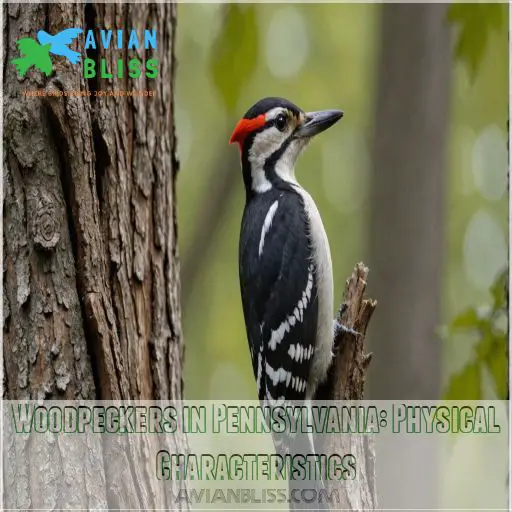
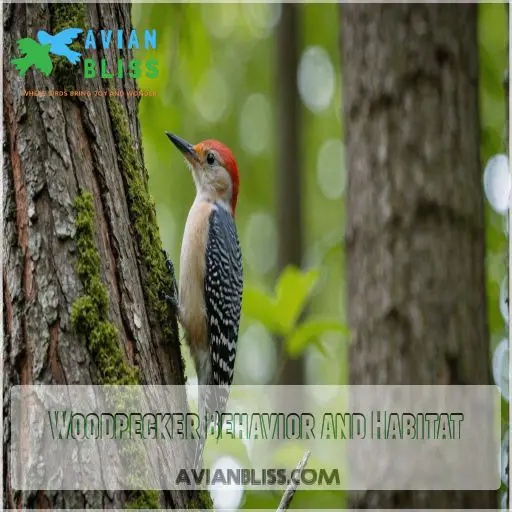
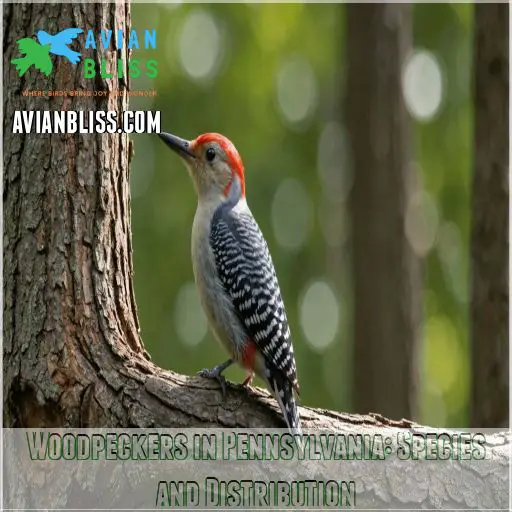
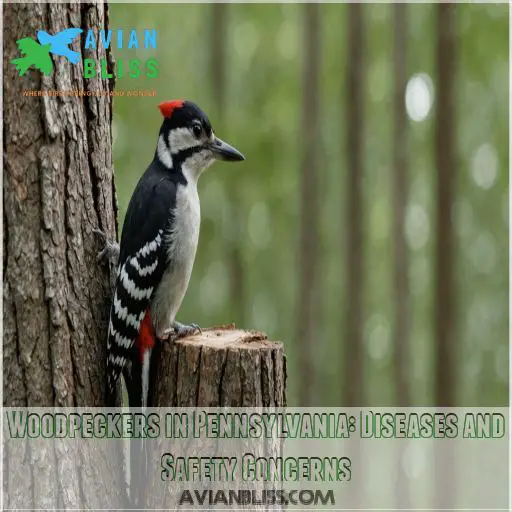
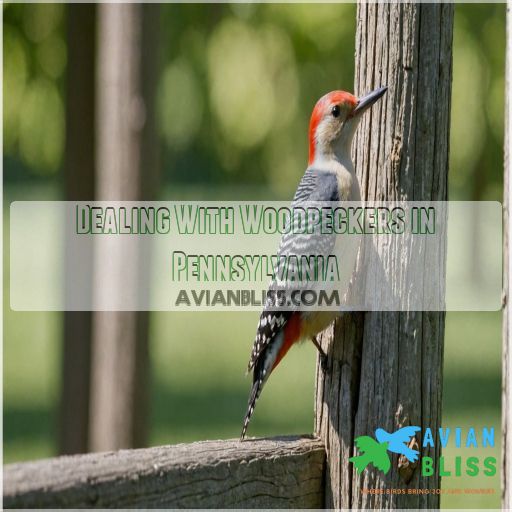

0 Comments